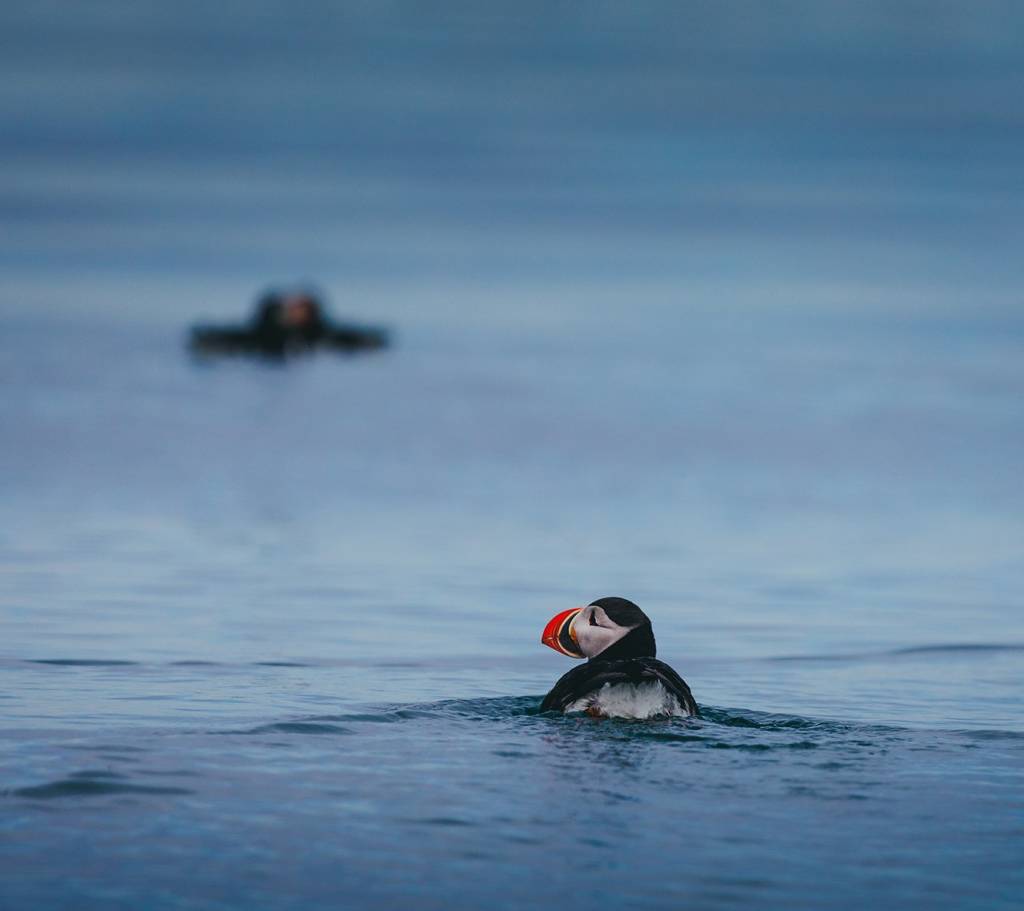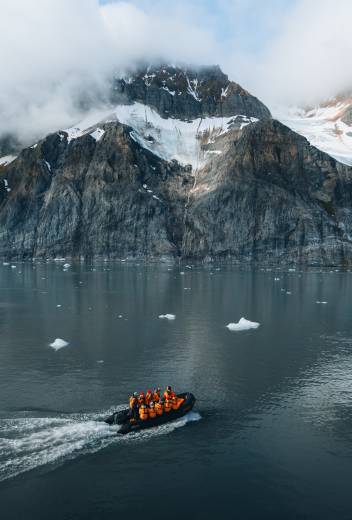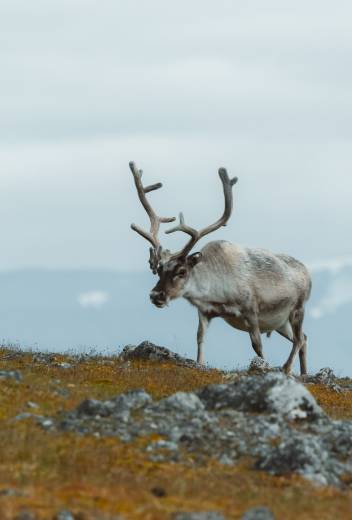
A pair of Atlantic penguins nest on the cliffs of Svalbard in the Norwegian Arctic. Photo: Acacia Johnson
Every creature in the wilderness possesses its own special attributes that endear itself to nature-lovers. Let’s be honest, who isn’t smitten with the puppy-like playfulness of a panda while others melt when met with the cuteness of a polar bear cub?
Puffins are similarly irresistible in their own special way, which perhaps explains why we at Quark Expeditions are so frequently asked where to see puffins in the Faroe Islands (termed by one puffin-fan as the Grand Central Station of Puffins). I chalk it up—but only partially—to the winged species’ appearance, notably its black-and-white coloring heightened by an intensely orange beak, which, as explained by an expert from the Audubon Penguin Project, fades in winter months. Curiously, Fratercula arctica, the Latin name for the Atlantic puffin, translates as “little brother” or “little friar of the north.” That totally makes sense when you behold their black and white plumage. They’re also called the Parrot of the Sea because of their colorful beak.
Their unique appearance aside, puffins also pique the curiosity of travelers with their surprising lifestyle habits and behaviors. Did you know that puffins typically couple up with the same partner year after year, much like certain species of penguins? While the females lay the one egg, the male shares the workload by taking its turn incubating that precious egg. And when the chick hatches—yes, you’ve got it, both parents take their turn feeding the baby small bits of fish from their beak.
I’ve also learned that puffins are creatures of habit. Puffin pairs often return to the same burrow each year, unlike other bird species that prefer to change up their seasonal dwelling. Not entirely uncommon in the bird world, puffins build burrows in the ground not high up on rocks or in trees (which are scarce in these parts). And what do puffins eat, you ask? For the most part, Atlantic puffins rely on a diet of fish and sand eels. That’d certainly explain why they spend so much time at sea. Check out our blog “Meet the Puffins” to learn about the various types of puffins and how to spot them out in the wilderness.
Some ornithologists believe the Atlantic puffin is one of the most numerous bird species in the Faroe Islands along with fulmars. And why are there so many puffins in Faroe Islands, that collection of islands between Norway and Iceland? The answer: the clifftops. The Faroe Islands are mountainous, full of valleys and grass-covered heaths marked by steep coastal cliffs that provide safe places for puffins to build their burrows and eventually lay and hatch their eggs.
Best places to see puffins in Faroe Islands
One of the best places to see puffins in Faroe Islands is Mykines, the westernmost of the 18 main islands that make up the archipelago. That’s definitely where to see puffins in the Faroe Islands. According to the Visit Vagar web site, “Puffins are the main attraction of Mykines. There are very few places where you can get this close to puffins as the area along the southern coast of Mykines.”

Puffins, unlike many other winged species, build burrows in clifftops rather than ‘traditional nests’in trees—not that there
are trees aplenty in the Norwegian Arctic anyway. Photo: Acacia Johnson
But it’s not just a question of where to see puffins in the Faroe Islands, you’ll see lots of other bird species there, as well. In addition to the roughly 125,000 pairs of Atlantic puffins on Mykines, there are northern fulmars and European storm petrels (some estimates suggest 50,000 pairs of both species), 23,000 pairs of black-legged kittiwakes, along with flocks of Manx shearwaters, northern gannets and guillemots. They’re all built to withstand – and thrive in – the harsh conditions of the Arctic. Globally respected ornithologist Noah Strycker, who wrote the birding bible, “Birding Without Borders,” talks about the sturdiness of Arctic birds in the video “How Birds Survive the Arctic.”
When is the Faroe Islands puffin season?
Puffins are found in the Faroe Islands from April to September. Experts suggest that as many as 1,000,000 birds breed in the Faroe Islands during the summer period. As mentioned above, this is an an ideal season to observe many bird species other than puffins. Expect to see thousands and thousands of chattering kittiwakes as well as gannets soaring across the sky to and from the cliff tops.
If you’re keen to add to your storehouse of bird knowledge, devote some time this evening or weekend to watching Quark Expeditions’ Polar Learning Channel episode dedicated to Arctic bird survival. That will also address a multitude of questions concerning when is the Faroe Islands puffin season.
When to see puffins in Faroe Islands
Of course, you want to visit the Faroe Islands not just when the puffins are present – but ideally when you can actually see them closer to land. Some photographers have expressed their preference to visit the Faroe Islands at the start of the season when the male and female are tending to the burrows. When to see puffins in Faroe Islands is when they lay their one egg, which is late April to early May. Luckily, this is in sync with Quark Expeditions’ visit to the Faroe Islands in May.

Puffins spend most of their time at sea. When not hunting for food (they eat a lot of fish)
they rest on the waves. Photo: Dave Merron
Joining a Faroe Islands puffin tour
Just as important as where to see puffins in the Faroe Islands is the matter of which Faroe Islands puffin tour you’ll want to book for your incredible puffin adventure. To successfully—and safely—experience a Faroe Islands puffin tour, you’ll want to travel with a company that has experience in the Polar Regions and has experts on staff who know where to seek out the best spots—and times—to observe puffins. Quark Expeditions, the Leader in Polar Adventures, has been taking travelers to the Arctic since 1991—longer than anyone else. And their fleet of small polar-sturdy vessels (never more than 199 passengers) are able to navigate where larger ships can’t.
For a truly rewarding Faroe Islands puffin tour, take a look at Quark Expeditions’ Arctic Saga: Exploring Spitsbergen via the Faroes and Jan Mayen. If you’re keen on bird-watching elsewhere in the Arctic, inquire about the Under the Northern Lights: Exploring Iceland and East Greenland. The bird cliffs in Spitsbergen will impress you just as mightily as the birding experience you’ll have in the Faroe Islands. Rest assured, you’ll be more smitten with these amazing creatures than you ever thought possible!









